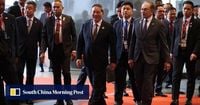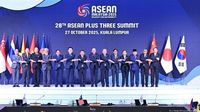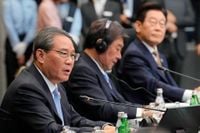On October 28, 2025, the bustling city of Kuala Lumpur bore witness to a momentous occasion as China and the Association of Southeast Asian Nations (ASEAN) inked an upgraded free trade pact, known as ACFTA 3.0. This landmark agreement, signed at the 28th ASEAN-China Summit, marked a new chapter in the economic relationship between China and the 11-nation Southeast Asian bloc, expanding their cooperation into cutting-edge sectors such as the digital and green economies, as well as supply chain connectivity.
The signing ceremony was more than a mere formality. Chinese Premier Li Qiang, addressing his Asian counterparts just a day before, urged the region to stand together against what he called “power politics,” a clear nod to the growing influence of U.S. tariffs and protectionist policies. According to China Global South, Li’s message was unmistakable: “We have a deep feeling that East Asia is faced with mounting difficulties and challenges in its economy and a growing instability and uncertainty in its development.” He called on the region to “uphold free trade and the multilateral trading system, oppose all forms of protectionism, and continuously advance regional economic integration.”
The timing of the ACFTA 3.0 signing was no coincidence. As reported by Reuters, the negotiations for this upgraded deal began in November 2022 and wrapped up in May 2025, just after U.S. President Donald Trump’s administration ramped up tariffs on imports from China and other countries. The impact of these tariffs was felt sharply across Southeast Asia, with some countries—like Cambodia—seeing tariff rates soar as high as 49 percent. While many ASEAN governments have since negotiated lower rates, the experience has prompted a collective move to reinforce trade ties with partners beyond the U.S., as a hedge against further unpredictability from Washington.
The new agreement is ambitious in both scope and scale. According to China’s Ministry of Commerce, ACFTA 3.0 introduces nine new chapters, covering everything from digital trade and green technology to bolstering supply chains. The goal? To future-proof the economic relationship in an era where digitalization and sustainability are becoming non-negotiable priorities. The pact is also expected to improve market access in sectors such as agriculture, the digital economy, and pharmaceuticals, as noted by Deutsche Welle (DW).
Since the original China-ASEAN Free Trade Area (CAFTA) came into force in 2010, the numbers have been nothing short of staggering. Bilateral trade between China and ASEAN has ballooned from $192.5 billion in 2008 to a whopping $982 billion in 2024, according to Chinese data cited by The Diplomat. The ASEAN bloc itself boasts a combined gross domestic product of $3.8 trillion, making it a heavyweight in the global economy.
For China, ASEAN is its largest trading partner, with bilateral trade totaling $771 billion in 2024, as reported by Reuters and DW. This economic partnership has become even more crucial as China faces criticism from other major powers over its export restrictions on rare earths and critical minerals. The stakes are high: Beijing’s recent moves to limit rare earth exports have alarmed industries worldwide, prompting European Council President Antonio Costa to meet with Premier Li Qiang at the summit to discuss potential resolutions. Costa, speaking to reporters, emphasized, “We are very concerned about the trade relationship with China. China knows very well what kind of problems we are facing and what China needs to do to overcome this situation.”
The ACFTA 3.0 signing was just one highlight in a week packed with diplomatic activity. The Regional Comprehensive Economic Partnership (RCEP)—the world’s largest trading bloc, encompassing nearly a third of the global population and about 30% of global GDP—held its first summit in five years in Kuala Lumpur on October 27, 2025. Both China and ASEAN are core members of RCEP, which some analysts see as a buffer against American tariffs, though its provisions are often considered less robust due to the diverse interests of its members.
Not to be outdone, U.S. President Donald Trump made his own mark on the summit. Arriving in Malaysia on October 26, Trump presided over the signing of trade agreements with Malaysia and Cambodia—though, notably, these did not reduce the stiff import tariffs set by his administration earlier in the year. Instead, they left the door open for possible exemptions down the road. Trump’s Asia tour continued with a high-profile visit to Japan, where he was set to meet Prime Minister Sanae Takaichi and discuss bilateral trade and defense. In a move that raised eyebrows, the Japanese prime minister announced plans to nominate Trump for the Nobel Peace Prize, as reported by DW.
Optimism over a potential U.S.-China trade deal sent Asian stock markets soaring at the start of the week, with investors betting that upcoming talks between Trump and Chinese President Xi Jinping could pause the escalating tariff war. Trump himself struck an upbeat tone, telling reporters, “It’s going to be great for China, great for us. I have a lot of respect for President Xi and we are going to I think... come away with a deal.” The two leaders were set to meet in South Korea later in the week at the Asia-Pacific Economic Cooperation (APEC) summit.
Yet, beneath the headline-grabbing diplomacy, the economic realities remain complex. While the U.S. has tightened its grip on trade policy, China has doubled down on its narrative as the champion of free and open trade. This message has found a receptive audience in Southeast Asia, where leaders like Malaysia’s Prime Minister Anwar Ibrahim have hailed the new ACFTA 3.0 as a “milestone” that will “open a new chapter in ASEAN’s strategic partnership with China and strengthen the region’s collective economic resilience.”
It’s not just about numbers and policy, though. The upgraded pact is a signal that, in a world of shifting alliances and rising protectionism, regional players are determined to carve out their own future. As Premier Li Qiang urged, the region’s response to “complex changes in the international economic and trade structure, especially the disruptions from high tariffs,” must be unity and a steadfast commitment to free trade.
For ASEAN and China, the ink on ACFTA 3.0 is still fresh, but the message is clear: the region is moving forward, together, with or without the blessing of Washington. As the dust settles in Kuala Lumpur, the world will be watching to see just how far this new era of cooperation can go.






